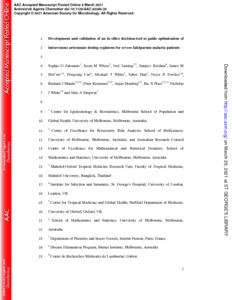Zaloumis, SG;
Whyte, JM;
Tarning, J;
Krishna, S;
McCaw, JM;
Cao, P;
White, MT;
Dini, S;
Fowkes, FJI;
Maude, RJ;
et al.
Zaloumis, SG; Whyte, JM; Tarning, J; Krishna, S; McCaw, JM; Cao, P; White, MT; Dini, S; Fowkes, FJI; Maude, RJ; Kremsner, P; Dondorp, A; Price, RN; White, NJ; Simpson, JA
(2021)
Development and Validation of an In Silico Decision Tool To Guide Optimization of Intravenous Artesunate Dosing Regimens for Severe Falciparum Malaria Patients.
Antimicrob Agents Chemother, 65 (6).
e02346-20.
ISSN 1098-6596
https://doi.org/10.1128/AAC.02346-20
SGUL Authors: Krishna, Sanjeev
![[img]](https://openaccess.sgul.ac.uk/113079/1.hassmallThumbnailVersion/Antimicrobial%20Agents%20and%20Chemotherapy-2021-Zaloumis-AAC.02346-20.full.pdf)  Preview |
|
PDF
Accepted Version
Available under License ["licenses_description_publisher" not defined].
Download (1MB)
| Preview
|
Abstract
Most deaths from severe falciparum malaria occur within 24 h of presentation to a hospital. Intravenous (i.v.) artesunate is the first-line treatment for severe falciparum malaria, but its efficacy may be compromised by delayed parasitological responses. In patients with severe malaria, the life-saving benefit of the artemisinin derivatives is their ability to clear circulating parasites rapidly, before they can sequester and obstruct the microcirculation. To evaluate the dosing of i.v. artesunate for the treatment of artemisinin-sensitive and reduced ring stage sensitivity to artemisinin severe falciparum malaria infections, Bayesian pharmacokinetic-pharmacodynamic modeling of data from 94 patients with severe malaria (80 children from Africa and 14 adults from Southeast Asia) was performed. Assuming that delayed parasite clearance reflects a loss of ring stage sensitivity to artemisinin derivatives, the median (95% credible interval) percentage of patients clearing ≥99% of parasites within 24 h (PC24≥99%) for standard (2.4 mg/kg body weight i.v. artesunate at 0 and 12 h) and simplified (4 mg/kg i.v. artesunate at 0 h) regimens was 65% (52.5% to 74.5%) versus 44% (25% to 61.5%) for adults, 62% (51.5% to 74.5%) versus 39% (20.5% to 58.5%) for larger children (≥20 kg), and 60% (48.5% to 70%) versus 36% (20% to 53.5%) for smaller children (<20 kg). The upper limit of the credible intervals for all regimens was below a PC24≥99% of 80%, a threshold achieved on average in clinical studies of severe falciparum malaria infections. In severe falciparum malaria caused by parasites with reduced ring stage susceptibility to artemisinin, parasite clearance is predicted to be slower with both the currently recommended and proposed simplified i.v. artesunate dosing regimens.
Statistics
Item downloaded times since 25 Mar 2021.
Actions (login required)
 |
Edit Item |



